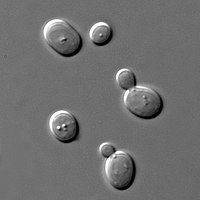
Photo from wikipedia
Candida glabrata is the second most common source of Candida infections in humans. In this pathogen, the maintenance of cell wall integrity (CWI) frequently precludes effective pharmacological treatment by antifungal… Click to show full abstract
Candida glabrata is the second most common source of Candida infections in humans. In this pathogen, the maintenance of cell wall integrity (CWI) frequently precludes effective pharmacological treatment by antifungal agents. In numerous fungi, cell wall modulation is reported to be controlled by endoplasmic reticulum (ER) stress, but how the latter affects CWI maintenance in C. glabrata is not clearly understood. Here, we characterized a C. glabrata strain harboring a mutation in the CNE1 gene, which encodes a molecular chaperone associated with nascent glycoprotein maturation in the ER. Disruption of cne1 induced ER stress and caused changes in the normal cell wall structure, specifically a reduction in the β-1,6-glucan content and accumulation of chitin. Conversely, a treatment with the typical ER stress inducer tunicamycin up-regulated the production of cell wall chitin but did not affect β-1,6-glucan content. Our results also indicated that C. glabrata features a uniquely evolved ER stress-mediated CWI pathway, which differs from that in the closely related species Saccharomyces cerevisiae. Furthermore, we demonstrated that ER stress-mediated CWI pathway in C. glabrata is also induced by the disruption of other genes encoding proteins that function in a correlated manner in the quality control of N-linked glycoproteins in the ER. These results suggest that calcineurin and ER quality control system act as a platform for maintaining CWI in C. glabrata.